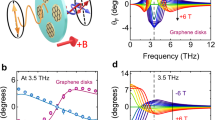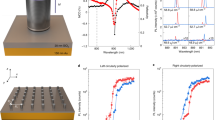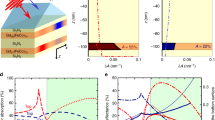Abstract
Strategies for the ultrafast optical control of magnetism have been a topic of intense research for several decades because of the potential impact in technologies such as magnetic memory1, spintronics2 and quantum computation, as well as the opportunities for nonlinear optical control and modulation3 in applications such as optical isolation and non-reciprocity4. Here we report experimental quantification of optically induced magnetization in plasmonic gold nanoparticles due to the inverse Faraday effect. The induced magnetic moment is large under typical ultrafast pulse excitation (<1014 W m−2 peak intensity), with magnetization and demagnetization kinetics that are instantaneous within the subpicosecond time resolution of our study. Our results support a mechanism of coherent transfer of angular momentum from the optical field to the electron gas, and open the door to all-optical subwavelength strategies for optical isolation that do not require externally applied magnetic fields.
This is a preview of subscription content, access via your institution
Access options
Access Nature and 54 other Nature Portfolio journals
Get Nature+, our best-value online-access subscription
$29.99 / 30 days
cancel any time
Subscribe to this journal
Receive 12 print issues and online access
$209.00 per year
only $17.42 per issue
Buy this article
- Purchase on Springer Link
- Instant access to full article PDF
Prices may be subject to local taxes which are calculated during checkout





Similar content being viewed by others
References
Stanciu, C. D. et al. All-optical magnetic recording with circularly polarized light. Phys. Rev. Lett. 99, 047601 (2007).
Wolf, S. A. et al. Spintronics: a spin-based electronics vision for the future. Science 294, 1488–1495 (2001).
Chai, Z. et al. Ultrafast all-optical switching. Adv. Opt. Mater. 5, 1600665 (2017).
Sounas, D. L. & Alù, A. Non-reciprocal photonics based on time modulation. Nat. Photon. 11, 774–783 (2017).
van der Ziel, J. P., Pershan, P. S. & Malmstrom, L. D. Optically-induced magnetization resulting from the inverse Faraday effect. Phys. Rev. Lett. 15, 190–193 (1965).
Mikhaylovskiy, R. V., Hendry, E. & Kruglyak, V. V. Ultrafast inverse Faraday effect in a paramagnetic terbium gallium garnet crystal. Phys. Rev. B 86, 100405 (2012).
Raja, M. Y. A., Allen, D. & Sisk, W. Room‐temperature inverse Faraday effect in terbium gallium garnet. Appl. Phys. Lett. 67, 2123–2125 (1995).
Belotelov, V. I., Bezus, E. A., Doskolovich, L. L., Kalish, A. N. & Zvezdin, A. K. Inverse Faraday effect in plasmonic heterostructures. J. Phys. Conf. Ser. 200, 092003 (2010).
Kimel, A. V. et al. Ultrafast non-thermal control of magnetization by instantaneous photomagnetic pulses. Nature 435, 655–657 (2005).
Hertel, R. Theory of the inverse Faraday effect in metals. J. Magn. Magn. Mater. 303, L1–L4 (2006).
Singh, N. D., Moocarme, M., Edelstein, B., Punnoose, N. & Vuong, L. T. Anomalously-large photo-induced magnetic response of metallic nanocolloids in aqueous solution using a solar simulator. Opt. Express 20, 19214–19225 (2012).
Nadarajah, A. & Sheldon, M. T. Optoelectronic phenomena in gold metal nanostructures due to the inverse Faraday effect. Opt. Express 25, 12753–12764 (2017).
Hurst, J., Oppeneer, P. M., Manfredi, G. & Hervieux, P.-A. Magnetic moment generation in small gold nanoparticles via the plasmonic inverse Faraday effect. Phys. Rev. B 98, 134439 (2018).
Gu, Y. & Kornev, K. G. Plasmon enhanced direct and inverse Faraday effects in non-magnetic nanocomposites. J. Opt. Soc. Am. B 27, 2165–2173 (2010).
Jain, P. K., Xiao, Y., Walsworth, R. & Cohen, A. E. Surface plasmon resonance enhanced magneto-optics (SuPREMO): Faraday rotation enhancement in gold-coated iron oxide nanocrystals.pdf. Nano Lett. 9, 1644–1650 (2009).
Svirko, Y. P. & Zheludev, N. I. Coherent and incoherent pump–probe specular inverse Faraday effect in media with instantaneous nonlinearity. J. Opt. Soc. Am. B 11, 1388–1393 (1994).
Zheludev, N. I. et al. Cubic optical nonlinearity of free electrons in bulk gold. Opt. Lett. 20, 1368–1370 (1995).
Hertel, R. & Fähnle, M. Macroscopic drift current in the inverse Faraday effect. Phys. Rev. B 91, 020411 (2015).
Wysin, G. M., Chikan, V., Young, N. & Dani, R. K. Effects of interband transitions on Faraday rotation in metallic nanoparticles. J. Phys. Condens. Matter 25, 325302 (2013).
Berritta, M., Mondal, R., Carva, K. & Oppeneer, P. M. Ab initio theory of coherent laser-induced magnetization in metals. Phys. Rev. Lett. 117, 137203 (2016).
Beaurepaire, E., Merle, J., Daunois, A. & Bigot, J. Ultrafast spin dynamics in ferromagnetic nickel. Phys. Rev. Lett. 76, 4250–4253 (1996).
Chen, T.-Y., Hsia, C.-H., Chen, H.-Y. & Son, D. H. Size effect on chemical tuning of spin−lattice relaxation dynamics in superparamagnetic nanocrystals. J. Phys. Chem. C 114, 9713–9719 (2010).
Chin, J. Y. et al. Nonreciprocal plasmonics enables giant enhancement of thin-film Faraday rotation. Nat. Commun. 4, 1599 (2013).
Gevorkian, Z. & Gasparian, V. Plasmon-enhanced Faraday rotation in thin films. Phys. Rev. A 89, 023830 (2014).
Yuan, Sh & Shu, X. Z. A new Faraday rotation glass with a large Verdet constant. J. Appl. Phys. 75, 6375–6377 (1994).
McGroddy, J. C., McAlister, A. J. & Stern, E. A. Polar reflection Faraday effect in silver and gold. Phys. Rev. 139, A1844–A1848 (1965).
Svirko, Y. P. & Zheludev, N. I. Polarization of Light in Nonlinear Optics (Wiley, 1998).
Wilks, R., Hughes, N. D. & Hicken, R. J. Investigation of transient linear and circular birefringence in metallic thin films. J. Phys. Condens. Matter 15, 5129–5143 (2003).
Kruglyak, V. V. et al. Ultrafast third-order optical nonlinearity of noble and transition metal thin films. J. Opt. A 7, S235–S240 (2005).
Kruglyak, V. V. et al. Measurement of hot electron momentum relaxation times in metals by femtosecond ellipsometry. Phys. Rev. B 71, 233104 (2005).
Hsia, C.-H., Chen, T.-Y. & Son, D. H. Size-dependent ultrafast magnetization dynamics in iron oxide (Fe3O4) nanocrystals. Nano Lett. 8, 571–576 (2008).
Bossini, D., Belotelov, V. I., Zvezdin, A. K., Kalish, A. N. & Kimel, A. V. Magnetoplasmonics and femtosecond optomagnetism at the nanoscale. ACS Photon. 3, 1385–1400 (2016).
Mangin, S. et al. Engineered materials for all-optical helicity-dependent magnetic switching. Nat. Mater. 13, 286–292 (2014).
Acknowledgements
We acknowledge the technical support of D. Rossi. This work was funded in part by the Gordon and Betty Moore Foundation through grant no. GBMF6882 and by the Air Force Office of Scientific Research under award no. FA9550-16-1-0154. M.S. also acknowledges support from the Welch Foundation (A-1886). D.H.S. appreciates support from the Institute for Basic Science (IBS-R026-D1).
Author information
Authors and Affiliations
Contributions
O.H.-C.C. carried out the measurements and analysed the data. D.H.S. and M.S. supervised the project and participated in the analysis of the data.
Corresponding authors
Ethics declarations
Competing interests
The authors declare no competing interests.
Additional information
Publisher’s note Springer Nature remains neutral with regard to jurisdictional claims in published maps and institutional affiliations.
Supplementary information
Supplementary Information
Supplementary Figs. 1–3, Discussion Sections 1–8 and Table 1.
Source data
Source Data Fig. 2
Numerical data for extinction spectra and Faraday rotation.
Source Data Fig. 3
Numerical data for figure.
Source Data Fig. 4
Numerical data for figure.
Source Data Fig. 5
Numerical data for figure.
Rights and permissions
About this article
Cite this article
Cheng, O.HC., Son, D.H. & Sheldon, M. Light-induced magnetism in plasmonic gold nanoparticles. Nat. Photonics 14, 365–368 (2020). https://doi.org/10.1038/s41566-020-0603-3
Received:
Accepted:
Published:
Issue Date:
DOI: https://doi.org/10.1038/s41566-020-0603-3
This article is cited by
-
Carbon Nitride Supported Ultra-fine Bismuth Sulfide Based Supercapacitor for Low Frequency Oscillator Application
Journal of Electronic Materials (2024)
-
Proposal to Observe Transverse Sound in Normal Liquid \(^3\)He in Aerogel
Journal of Low Temperature Physics (2024)
-
Strong transient magnetic fields induced by THz-driven plasmons in graphene disks
Nature Communications (2023)
-
Attosecond magnetization dynamics in non-magnetic materials driven by intense femtosecond lasers
npj Computational Materials (2023)
-
MOF-Like 3D Graphene-Based Catalytic Membrane Fabricated by One-Step Laser Scribing for Robust Water Purification and Green Energy Production
Nano-Micro Letters (2022)



